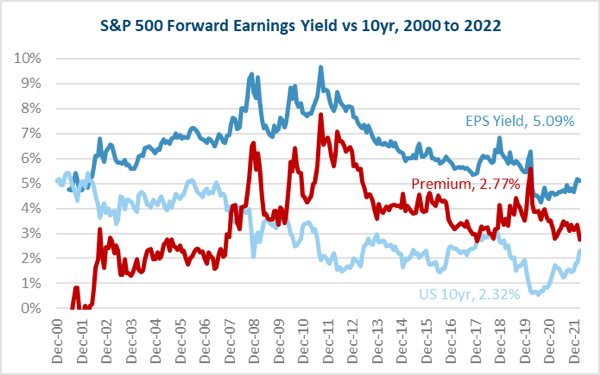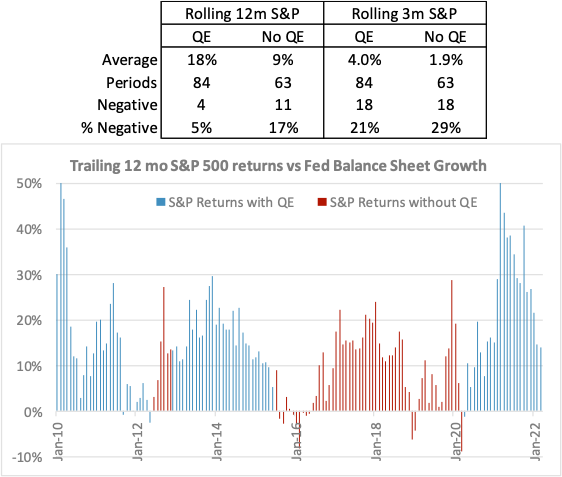On 12/31/21, we wondered in Will the Fed Shift Market Returns Into a Lower Gear?, if shifting Fed policy would impact market returns. More specifically, we pointed out that rising interest rates would be a threat to both bonds (via duration) and higher PE growth stocks. We also noted the ability for stocks to absorb some of the impact of rising rates, as long as it was offset by growing profits.

Q1’22’s combined 5% decline in the S&P 500 and 6% decline in the Barclays Aggregate resulted in the standard 60/40 portfolio recording its worst return since 2008. Unlike 2008, when major equity declines could not be offset by small rise in bonds, Q1’22 saw both stocks and bonds decline modestly due to the headwind of rising rates. The slight equity outperformance showed how rising profits can offset rising rates. With the 10yr jumping 81 bps during Q1’22, the S&P 500 earnings yield premium over the 10yr Treasury yield did compress, from 3.4% to 2.8%. But stocks were able to absorb some of this due to higher profits, as the earnings yield rose from 4.7% to 5.1%. The current premium of 2.8% is at the low end of its post 2008 range, but in line with the pre-2008 period, when interest rates were higher. Within equity, we also noted that the recent trend was Value outperforming Growth when rates were rising. This also proved to be a notable trend in Q1’22, as Value was flat in Q1’22, compared to a nearly 9% decline in Growth. Combined, the cushion in the yield premium and support from Value stocks limited the pull back in stocks.

While the Fed raising rates was the big headline in Q1’22, because the markets have so rapidly moved to price six or more rate hikes, the focus is going to shift to the Fed’s other policy tool, its balance sheet. Expanding its balance sheet, known as Quantitative Easing (QE), came to an end in March as the taper concluded. Its about to be replaced by Quantitative Tightening (QT), the process of allowing the balance sheet to shrink.
QE supported asset prices. As the chart and table shows, periods with QE have 18% average 12 month returns, compared to 9% without it. And anecdotally from the chart, 2016 (QE taper) and late 2018 (the only other period of QT) are the two periods of when the Fed slowed QE, and both were rocky markets. This is illustrated by the “% Negative” calculation, which is the percentage of periods when returns were below zero. For rolling 12-month periods, it goes from 5% during QE periods, to 17% in non-QE periods. QE has afforded markets a smooth ride since it was restarted in April 2020, despite the ongoing volatility in the economic numbers.
As noted on 12/31/21: 2022 could be the opposite: the economy could continue to normalize, but as QE’s asset price support falls away, the markets could return to normal, too. Though in this case normal means lower returns and higher volatility than the period since April 2020. As the table shows, returns still averaged 9% in non-QE periods, which is in line with historic rates of return. But that could seem low, and when paired with more normal volatility and an occasional 10% correction, “normal” might take some getting used to.
Q1’22 saw the first part of the Fed shifting its policy, as higher interest rates at the short end of the yield curve now price a very aggressive Fed rate hike path. Because of this repricing, in Q1’22 equity markets fell modestly, volatility rose, and there was an unpleasant, though normal, 10% correction. The bond markets experienced a more challenging environment due to their duration sensitivity to interest rates. Investors entering 2022 anticipating the possibility of a return to a more normal trading environment were better equipped to handle it. And with the short end of the curve now reflecting a series of interest rate hikes, the market has digested this news. Similarly, knowing the second stage of the Fed’s shift, the roll-out of QT, could also bring a period of digestion can be helpful. This does not mean the process will not be uncomfortable at points, but it can be manageable. Will QT Get Ugly for the Markets? Possibly, though by knowing it is the result of Fed shifts and the underlying economy remains solid, we can remain able to handle it, with a combination of properly diversified portfolios and reasonable expectations.
Important Disclosures:
Please remember that past performance may not be indicative of future results. Different types of investments involve varying degrees of risk, and there can be no assurance that the future performance of any specific investment, investment strategy, or product (including the investments and/or investment strategies recommended or undertaken by Grimes & Company, Inc. [“Grimes]), or any non-investment related content, made reference to directly or indirectly in this commentary will be profitable, equal any corresponding indicated historical performance level(s), be suitable for your portfolio or individual situation, or prove successful. Due to various factors, including changing market conditions and/or applicable laws, the content may no longer be reflective of current opinions or positions. Moreover, you should not assume that any discussion or information contained in this commentary serves as the receipt of, or as a substitute for, personalized investment advice from Grimes. Grimes is neither a law firm, nor a certified public accounting firm, and no portion of the commentary content should be construed as legal or accounting advice. A copy of the Grimes’ current written disclosure Brochure discussing our advisory services and fees continues to remain available upon request or at www.grimesco.com. Please Remember: If you are a Grimes client, please contact Grimes, in writing, if there are any changes in your personal/financial situation or investment objectives for the purpose of reviewing/evaluating/revising our previous recommendations and/or services, or if you would like to impose, add, or to modify any reasonable restrictions to our investment advisory services. Unless, and until, you notify us, in writing, to the contrary, we shall continue to provide services as we do currently. Please Also Remember to advise us if you have not been receiving account statements (at least quarterly) from the account custodian.
Historical performance results for investment indices, benchmarks, and/or categories have been provided for general informational/comparison purposes only, and generally do not reflect the deduction of transaction and/or custodial charges, the deduction of an investment management fee, nor the impact of taxes, the incurrence of which would have the effect of decreasing historical performance results. It should not be assumed that your Grimes account holdings correspond directly to any comparative indices or categories. Please Also Note: (1) performance results do not reflect the impact of taxes; (2) comparative benchmarks/indices may be more or less volatile than your Grimes accounts; and, (3) a description of each comparative benchmark/index is available upon request.
The information contained herein is based upon sources believed to be true and accurate. Sources include: Factset Research Systems Inc., Bureau of Economic Analysis, Bureau of Labor Statistics, Congressional Budget Office, Board of Governors of Federal Reserve System, Fred: Federal Reserve Bank of St. Louis Economic Research, U.S. Department of the Treasury
-The Standard & Poor’s 500 is a market capitalization weighted index of 500 widely held domestic stocks often used as a proxy for the U.S. stock market. The Standard & Poor’s 400 is a market capitalization weighted index of 400 mid cap domestic stocks. The Standard & Poor’s 600 is a market capitalization weighted index of 600 small cap domestic stocks.
-The NASDAQ Composite Index measures the performance of all issues listed in the NASDAQ stock market, except for rights, warrants, units, and convertible debentures.
-The MSCI EAFE Index (Europe, Australasia, Far East) is a free float-adjusted market capitalization index that is designed to measure the equity market performance of developed markets, excluding the US & Canada. The MSCI Emerging Markets Index is a free float-adjusted market capitalization index that is designed to measure equity market performance of 21 emerging markets. The MSCI All Country World Index is a free float adjusted market capitalization index designed to measure the performance of large and mid and cap stocks in 23 developed markets and 24 emerging markets. With over 2,800 constituents it represents over 85% of the global equity market.
-The Barlcays Aggregate Index represents the total return performance (price change and income) of the US bond market, including Government, Agency, Mortgage and Corporate debt.
-The BofA Merrill Lynch Investment Grade and High Yield Indices are compiled by Bank of America / Merrill Lynch from the TRACE bond pricing service and intended to represent the total return performance (price change and income) of investment grade and high yield bonds.
-The S&P/LSTA U.S. Leveraged Loan 100 is designed to reflect the largest facilities in the leveraged loan market. It mirrors the market-weighted performance of the largest institutional leveraged loans based upon market weightings, spreads and interest payments.
-The S&P Municipal Bond Index is a broad, comprehensive, market value-weighted index. The S&P Municipal Bond Index constituents undergo a monthly review and rebalancing, in order to ensure that the Index remains current, while avoiding excessive turnover. The Index is rules based, although the Index Committee reserves the right to exercise discretion, when necessary.
-The BofA Merrill Lynch US Emerging Markets External Sovereign Index tracks the performance of US dollar emerging markets sovereign debt publicly issued in the US and eurobond markets.
-The HFRI Fund of Funds index is compiled by the Hedge Funds Research Institute and is intended to represent the total return performance of the entire hedge fund universe.



